Sample Return
This sample return uses actual forms to show you how to prepare your income tax return. However, the information shown on the filled-in forms is
not from any actual farming operation.
Walter Brown is a dairy farmer and his wife, Jane, is a substitute teacher for the county school system. They have three children. Their return has
been prepared using the cash method of accounting. See chapter 3 for an explanation of the cash method and other methods of accounting.
Rounding off to whole dollars.
You may round off to the nearest whole dollar on your return and schedules. This will make it easier to complete your return. To do so, drop
amounts under 50 cents and increase amounts from 50 to 99 cents to the next dollar. For example, $129.49 becomes $129 and $235.50 becomes $236.
If you do round off, do so for all amounts. However, if you have to add two or more amounts to figure the total to enter on a line, include cents
when adding the amounts and round off only the total.
Losses from operating a farm.
The sample return shows a profit from the operation of the farm. However, if your deductible farm expenses are more than your farm income for the
year, you have a loss from the operation of your farm. If your loss is more than your other income for the year, you may have a net operating loss
(NOL). You may also have an NOL if you had a personal or business-related casualty or theft loss that was more than your income.
If you have an NOL this year, you may be able to reduce your income (and tax) in other years by carrying the NOL to those years and deducting it
from income.
To determine if you have an NOL, complete your tax return for the year. You may have an NOL if a negative figure appears on line 39 of Form 1040.
If this is the case, see Losses From Operating a Farm in chapter 5.
Preparing the Return
Schedule F (Form 1040)
The first step in preparing Mr. Brown's income tax return is to determine his net farm profit or loss on Schedule F. The income and expenses shown
on this Schedule F are taken from his farm receipt and expense records. Data for the depreciation and section 179 deductions are taken from Form 4562
and the illustrated Depreciation Worksheet that follows Form 4562. Mr. Brown has filed all required Form 1099 information returns.
On line B, he writes the number 112120 from the list of Principal Agricultural Activity Codes on page 2 of Schedule F (not
shown). This indicates that his principal source of farm income is from dairy farming.
Schedule F - Part I (Income)
Mr. Brown keeps records of the various types of farm income he receives during the year. (Farm income is discussed in chapter 4.) He uses this
information to complete Part I of Schedule F.
Line items.
He fills in all applicable items of farm income.
Line 1.
In 2002, he sold steers he had bought for resale. He enters sales of $26,584.
Line 2.
He enters the cost of the steers, $6,523. He has kept a record of the cost of the livestock he bought and is careful to deduct the cost of an
animal in the year of its sale.
Line 3.
He subtracts his cost on line 2 from the sales on line 1 and reports the difference, $20,061, as his profit on line 3. Had he sold any other items
he bought for resale, he would combine the sales and costs of these items with the sales and costs of the steers and report only the totals on lines
1, 2, and 3. He does not report here sales of livestock held for draft, breeding, sport, or dairy purposes. He reports those sales on Form 4797.
Line 4.
He enters the income he received during 2002 from sales of items he raised or produced on his farm. His principal source of farm income is dairy
farming. The amount reported on this line, $213,018, includes sales of all of the following.
| Milk |
$183,874 |
| Steers and calves he raised |
2,914 |
| Vegetables he grew |
1,457 |
| Corn ($7,286), hay ($8,944), and wheat ($8,543) he raised |
24,773 |
| Total reported on line 4 |
$213,018 |
Lines 5a and 5b.
He reports the $33 he received from cooperatives on line 5a. Since this is the dollar amount of a qualified written notice of allocation paid as
part of a patronage dividend, he enters $33 as the taxable amount on line 5b.
Lines 6a and 6b.
He received Farm Service Agency (FSA) cost-sharing payments of $438 on a soil conservation project (diversion channels) completed in 2002. He
received the income as materials and services paid for by the government and reports it on both line 6a and line 6b. The Department of Agriculture
(USDA) generally reports such payments to the recipient on Form 1099-G. The entire $438 has been included on line 14 of Schedule F as a
conservation expense. He did not receive any cost-sharing payments this year that he could exclude from his farm income.
Line 7a.
He reports the $665 loan he received from the Commodity Credit Corporation (CCC) because he elected in a previous year to treat these loans as
income in the year received. (If he had elected not to report his CCC loan as income in the year received and forfeited the loan in a later year, he
would report the loan as income on lines 7b and 7c in the year of forfeiture.)
Line 9.
He reports his $1,258 of income from custom harvesting.
Line 10.
On his 2001 income tax return, he claimed a credit of $142 for excise taxes on gasoline used on his farm. He includes the entire $142 in his 2002
income on line 10 because he deducted the total cost of gasoline (including the $142 of excise taxes) as a farm business expense in 2001. He also
includes $250 he received as a director of the local milk marketing cooperative and $175 received for firewood he cut and sold in 2002.
Schedule F - Part II (Expenses)
Mr. Brown records his farm expenses during the year for tax purposes and summarizes these expenses at the end of the year. (Farm business expenses
are discussed in chapter 5.) This gives him his deductible expenses, which he enters in Part II of Schedule F.
Line items.
He fills in all applicable items of farm expense deductions.
Line 12.
He uses his trucks 100% for his farming business and the actual cost (not including depreciation) of operating the trucks in 2002 was $2,659. He
uses his family car 60% for business (determined by records at year end). It cost $2,307 to operate the car in 2002. He can deduct $1,384 for the car
($2,307 × .60). He enters a total of $4,043 ($2,659 + $1,384) on line 12. (Depreciation is reported on line 16.)
Line 13.
The $2,701 on this line is the amount he paid for pesticides and herbicides purchased during the year.
Line 14.
He deducts the $1,040 spent on diversion channels in 2002. The amount listed here includes the full cost of the government cost-sharing project,
which he has reported as income on line 6. He continues the policy elected in previous years of deducting annual soil and water conservation expenses.
The expenses are consistent with a conservation plan approved by the Natural Resources Conservation Service of the USDA.The amount was not more than
25% of Mr. Brown's gross income from farming, so the entire amount is deductible. See chapter 6 for more information on soil and water conservation
expenses.
Line 15.
The $1,575 on this line is the amount he paid a company for spraying his crops. He made the payment to a corporation, so he does not file a Form
1099-MISC to report the payment.
Line 16.
He enters the $80,621 depreciation from Form 4562, discussed later.
Line 18.
He enters the $18,019 cost of feed bought for consumption by his livestock in 2002. He did not include the cost of feed bought for livestock he and
his family intend to consume. He also did not include the value of feed grown on his farm.
Line 19.
He enters $6,544. This is the amount paid for fertilizer and lime.
Line 20.
He deducts the $5,105 he paid for trucking and milk marketing expenses. He chose to itemize the $807 government milk assessment and lists it
separately on line 34a.
Line 21.
He deducts the $3,521 cost of gasoline, fuel, and oil bought for farm use, other than amounts he included on line 12 for car and truck expenses. He
did not deduct the cost of fuel used for heating, lighting, or cooking in his home.
Line 22.
He deducts the $1,070 cost of insurance on his farm buildings (but not on his home), equipment, livestock, and crops. He did not deduct the entire
premiums on 3-year and 5-year insurance policies in the year of payment, but deducts each year only the part that applies to that year. For more
information, see Insurance in chapter 5.
Lines 23a and 23b.
He deducts on line 23a the $3,175 interest paid on the farm mortgage for the land and buildings used in farming. He deducts on line 23b the $1,043
interest paid on obligations incurred to buy livestock and other personal property used in farming or held for sale. He deducts his home mortgage
interest on Schedule A (Form 1040), which is not shown.
Line 24.
He enters the $16,416 in wages he paid during the year for labor hired to operate his farm, including wages paid to his wife and children. He did
not include amounts paid to himself. He has no employment credits that would reduce the amount of wages entered. For those wages paid that were
subject to social security and Medicare taxes, he included the full amount of the wages before reduction for the employee's share of those taxes, or
other amounts withheld. His share of the social security and Medicare taxes is included in the total taxes deducted on line 31. See chapter 16 for
information on employment taxes.
Line 26b.
He enters only the $2,400 cash rent paid for the use of land he rented from a neighbor, Mr. Green. He did not deduct rent paid in crop shares. He
completed a Form 1099-MISC for the rent paid to Mr. Green and sent Copy A to the IRS with Form 1096. He gave Mr. Green a copy of the Form
1099-MISC.
Line 27.
The $5,424 he enters includes $4,902 for repairs to farm machinery and $522 for repairs to farm buildings. He did not include the value of his own
labor or the cost of repairs on his home. He prepared Form 1099-MISC for the farm machinery repairs because the repair shop is a limited
liability company (LLC) that is not classified as a corporation. He sent Copy A to the IRS with Form 1096 and gave a copy to the owner of the repair
shop. If the repair shop had been a corporation, Mr. Brown would not have had to file a Form 1099-MISC. He does not have to file a Form
1099-MISC for the building repair because he paid less than $600.
Line 28.
He enters the $2,132 cost of seeds and plants used in farming. He deducts these costs each year. He did not include the cost of plants and seeds
purchased for the family garden.
Line 30.
He enters the $2,807 paid for livestock supplies and other supplies, including bedding.
Line 31.
He enters $3,201 for taxes paid during 2002, including state and local taxes on the real estate and personal property used in farming. He did not
include the sales tax paid on farm supplies because this tax was included in the cost for supplies he deducted on line 30. He also did not include the
gasoline tax on the gasoline bought for farm use, including the gasoline used in his trucks and family car for farm business, because these taxes were
included in the costs for gasoline he deducted on lines 21 and 12. He included his share of social security and Medicare taxes paid for agricultural
employees. He filed Form 943 (not shown) in January 2003, reporting these taxes for calendar year 2002.
He does not deduct, on Schedule F, his state income tax or the taxes on his home and the part of his land not used for farming. He deducts these
taxes on Schedule A (Form 1040), which is not shown. He does not deduct any federal income tax paid during the year.
Line 32.
He enters $3,997 for the cost of water, electricity, gas, and telephone service used only in farming. He cannot deduct personal utilities. He also
cannot deduct the cost of basic local telephone service (including any taxes) for the first telephone line to his home.
Line 33.
He enters $3,217, the total paid during 2002 for veterinary fees ($1,821), livestock medicines ($650), and breeding fees ($746). He does not
prepare Form 1099-MISC for the veterinarian and the supplier of breeding services because both are incorporated.
Line 34.
He enters other farm business expenses. These include: an $807 government milk assessment; $347 for commissions, dues, and fees; $287 for financial
records and office supplies; and $534 for farm business travel and meals. Farm business travel includes expenses for the State Forage Tour and for
attending the farm management conference at State University. He included only 50% of the cost of meals in the deduction.
Line 36 - Net farm profit.
To arrive at his net farm profit, he subtracts the amount on line 35 ($170,026) from the amount on line 11 ($236,040). His net farm profit, entered
on line 36, is $66,014. He also enters that amount on line 18 of Form 1040, and on line 1 of Section A, Schedule SE (Form 1040). Because he shows a
net profit on line 36, he skips line 37.
Form 4562 - Depreciation and Amortization
Mr. Brown follows the instructions and lists the information called for in Parts I through IV. He also completes Part V on page 2 to provide
information on listed property used in his farming business. The three vehicles used in his business are listed property. The truck, sold in July and
shown on Form 4797, was placed in service in 1993 and fully depreciated in 1998. No depreciation is allowed for 2002.
Depreciation record.
He records information on his depreciable property in a book that he can use to figure his depreciation allowance for several years. He uses the
Depreciation Worksheet from the Form 4562 instructions to figure his 2002 deduction.
Basis for depreciation.
He bought his farm on January 8, 1978. Timber on the farm was immature and had no fair market value (FMV). He immediately allocated the total
purchase price of the farm among the land, house, barn, and fences (no other capital improvements were included in the price of the farm). He made the
allocation on the purchase date in proportion to (but not in excess of) the FMVs of the assets and in the required asset order. See Trade or
Business Acquired in Publication 551 for more information.
He entered in his depreciation record the part of the purchase price for the depreciable barn and fences, giving him the basis for figuring his
depreciation allowance. The fences were fully depreciated in 1987. Because he cannot depreciate the house and land, he keeps a separate record showing
their bases.
Methods of depreciation.
He depreciates all his property placed in service before 1981 using the straight line method. He chose the alternate Accelerated Cost Recovery
System (ACRS) method for his machine shed placed in service in 1986. He chose the following systems for all of his assets placed in service in the
year indicated using the Modified Accelerated Cost Recovery System (MACRS) and the half-year convention.
- 1998 - straight line Alternative Depreciation System (ADS).
- 1999 - 150% declining balance ADS.
- 2000 and 2002 - 150% declining balance General Depreciation System (GDS).
Depreciable property.
One of his purchased dairy cows (#42) was killed by lightning in July 2002. Two other purchased cows (#52 and #60) were sold in 2002. The cows were
depreciated under MACRS (ADS), using a half-year convention. Therefore, he can claim a half-year's depreciation for each cow in 2002.
He has other breeding and dairy cows he raised. He did not claim depreciation on them since his basis in the cows is zero for income tax purposes.
During 2002 the Browns owned two family cars. One of them was not used for farm business. Mr. Brown cannot deduct depreciation on it. Based on his
written records, he determined at the end of the year that his other car was used 60% for his farm business and 40% for personal driving.
The Depreciation Worksheet contains an itemized list of Mr. Brown's assets for which he is deducting depreciation in 2002. He must list
each item separately to keep track of its basis. The pickup truck and car purchased in 1999 are listed property in the 5-year property class.
New assets.
Mr. Brown added three assets to his farming business in 2002.
- In January, he completed and placed in service a dairy facility designed specifically for the production of milk and to house, feed, and
care for dairy cattle (single purpose livestock structure). The building is depreciated separately from the milking equipment it houses. The cost of
the building is $56,500 and it is 10-year property under MACRS. The cost of the equipment is $72,000 and it is 7-year property under MACRS.
- In February, he made improvements to his machine shed for a total cost of $1,300. The improvements are depreciated as if they were a
separate building with a 20-year recovery period.
- In July, he acquired a new tractor (tractor #5) by trading tractor #2 and paying $33,729 cash. The adjusted basis of tractor #2 was $1,378
when it was traded (Mr. Brown claimed half a year of depreciation). The new tractor has a basis of $35,107 ($33,729 + $1,378). The portion of the new
basis carried over from tractor #2 ($1,378) is depreciated over the remaining life of tractor #2. Therefore, Mr. Brown left the depreciation of that
portion of the basis on his Depreciation Worksheet as if he still owned tractor #2 but made a note that the remaining basis on that line is part of
his basis in tractor #5. Mr. Brown made a new entry on his Depreciation Worksheet to depreciate the $33,729 of new basis in tractor #5 over the new
7-year life of tractor #5. He completed Form 8824, Like-Kind Exchanges, (not shown) to report the trade and will include this form when he
files his return. He elected to expense part of the cost of the tractor in 2002 and depreciate the rest of the new basis.
Line items.
Form 4562 is completed by referring to the Depreciation Worksheet.
Line 2.
Mr. Brown enters $162,229 on line 2. This is the total cost of all section 179 property placed in service in 2002. In figuring his cost, he does
not include the portion of the new basis in the acquired tractor that was carried over from the traded tractor ($1,378). The dairy facility and
equipment qualify as section 179 property. However, the machine shed improvement does not qualify. It is not a single purpose agricultural (livestock)
structure.
Line 6.
He enters the description of the property (tractor) he is electing to expense under section 179. His cost basis for the section 179 deduction is
limited to the cash he paid for the tractor. He enters his cost basis of $33,729 in column (b). He then enters the tentative deduction, $24,000, in
column (c). However, this amount is subject to the business income limit on line 11. (The total cost of his section 179 property did not exceed the
investment limit, $200,000, and he is therefore subject to the maximum dollar limit, $24,000.)
Lines 11 and 12.
His taxable income from his farming business (without including the section 179 deduction and the self-employment tax deduction) exceeds the
maximum dollar limit on line 5. He enters $24,000 on lines 11 and 12. See chapter 8 for information on the section 179 deduction.
Line 14.
He also chooses to deduct the special depreciation allowance for the properties that qualify. The allowance is an additional 30% of the property's
cost or basis (after subtracting the section 179 deduction).
Line 16.
He enters $568 for his other depreciation. The $568 is for the asset placed in service before 1981 and the asset depreciated under ACRS.
Line 17.
He enters $2,823. This is his MACRS depreciation for assets placed in service from 1998 through 2000.
Line 19.
All property placed in service in 2002 in each class is combined and entered in Part III, line 19. The abbreviation HY used in column (e) stands
for the half-year convention. The 150 DB in column (f) stands for the 150% declining balance method under MACRS.
Line 21.
He enters his depreciation deduction for listed property, $2,244, on line 21. This is the total shown on line 28, Part V, page 2 of the form. He
has two depreciable assets that are listed property - the car used 60% for business and the pickup truck purchased in 1999. His deduction for the
car cannot be more than 60% of the limit for passenger automobiles for the year he placed the car in service. The other truck, which he sold this
year, was fully depreciated.
Line 22.
He enters the total depreciation on line 22 and carries the total, $80,621 to line 16 of Schedule F.
Other items.
He completes Sections A and B of Part V to provide the information required for listed property. He does not complete Section C because he does not
provide vehicles for his employees' use.
He follows the practice of writing down the odometer readings on his vehicles at the end of each year and when he places the vehicles in service
and disposes of them. In addition, because he uses his car only partly for business, he writes down the number of business miles it is driven any day
that it is used for business. He uses these records to answer the questions on lines 24a and 24b of Section A and lines 30 through 36 of Section B.
He has no amortization, so he does not use Part VI of Form 4562.
Schedule SE (Form 1040) Self-Employment Tax
After figuring his net farm profit on page 1 of Schedule F, Mr. Brown figures his self-employment tax. To do this, he figures his net earnings from
farm self-employment on Short Schedule SE (Section A). He is not required to use Long Schedule SE (Section B). First he prints his name (as shown on
his Form 1040) and his social security number at the top of Schedule SE. Only his name and social security number go on Schedule SE. His wife does not
have self-employment income. If she had self-employment income, she would file her own Schedule SE.
Line items.
He figures his self-employment tax on the following lines.
Line 1.
He enters his net farm profit, $66,014. All the income, losses, and deductions listed on Schedule F are included in determining net earnings from
farm self-employment (see the types of self-employment income listed in chapter 15). Consequently, he did not have to adjust his net profit to
determine his self-employment net earnings from farming.
Line 3.
If he were engaged in one or more other businesses in addition to farming, he would combine his net profits from all his trades or businesses on
line 3 of this schedule. However, because farming was his only business, he enters his net profit from farming (the amount shown on line 1).
Line 4.
He multiplies line 3 by .9235 to get his net earnings from self-employment and enters $60,964 on line 4.
Lines 5 and 6.
He multiplies line 4 by 15.3% and enters $9,327 on line 5. This is his self-employment tax for 2002. He also enters $9,327 on line 56 of Form 1040.
He enters $4,664 on line 6 and also on line 29 of Form 1040 (deduction for one-half of his self-employment tax).
Form 4684 - Casualties and Thefts
Mr. Brown's only business casualty occurred on July 7 when a dairy cow he purchased 4 years ago was killed by lightning. He shows the loss from the
casualty on page 2 of Form 4684. Only page 2 is shown, because page 1 is for nonbusiness casualties.
He prints his name, his wife's name, and his identifying number at the top of page 2.
Part I.
He prints the kind of property, Dairy cow #42, its location, and the date acquired on line 19. He enters his adjusted basis in the cow,
$257, on line 20 and the $109 insurance payment he received for the cow on line 21. Line 20 is more than line 21, so he skips line 22. On lines 23 and
24, he enters the FMVs before and after the casualty ($500 and $0, respectively), and he shows the difference, $500, on line 25. He enters the amount
from line 20 on line 26, subtracts line 21 from line 26, and enters $148 on lines 27 and 28.
Part II.
He owned the cow for more than one year, so he identifies the casualty on line 34 and enters $148 on lines 34(b)(i), 35(b)(i), 37, and 38a, and on
Form 4797, Part II, line 14.
Form 4797 - Sales of Business Property
After completing Schedule F (Form 1040) and Section B of Form 4684, Mr. Brown fills in Form 4797 to report the sales of business property. See
Table 11-1 in chapter 11 for the types of property reported on Form 4797.
He prints his name, his wife's name, and his identifying number at the top of Form 4797.
Before he can complete Parts I and II, he must complete Part III to report the sale of certain depreciable property.
Part III.
Mr. Brown sold three depreciable assets in 2002 at a gain. They consisted of a truck, a mower, and a purchased dairy cow, #60. He has information
about their cost and depreciation in his records. Only the dairy cow appears on the Depreciation Worksheet. The truck and mower were fully
depreciated.
He sold the truck on July 9, the mower on August 12, and the cow on October 28. Since the gains on these items were gains from dispositions of
depreciable personal property, as explained in chapter 11, he must determine the part of the gain for each item that was ordinary income.
He enters the description of each item on lines 19A through 19C and relates the corresponding property columns to the properties on those lines. He
completes lines 20 through 25(b) for each disposition.
Gain from dispositions.
The gain on each item is shown on line 24. His gain on the sale of the truck is $700 (Property A). His gain on the sale of the mower is $70
(Property B). His gain on the sale of the cow is $82 (Property C). The gain on each item is entered in the appropriate property column on line 25(b).
Summary of Part III gains.
On line 30, he enters $852, the total of property columns A through C, line 24. On line 31, he enters $852, the total of property columns A through
C, line 25(b). This amount is the gain that is ordinary income. He also enters this amount on line 13, Part II.
He subtracts line 31 from line 30 and enters -0- on line 32. He has no long-term capital gain on the dispositions. All his gain is ordinary income.
Part I.
All the animals in Part I met the required holding period.
Mr. Brown sold at a gain several cows he had raised and used for dairy purposes. His selling expense was $325 for these cows, which he shows on
line 2(f). He enters the gain from the sale on line 2(g). He also shows on line 2(f), a selling expense of $20 for a raised dairy heifer and enters on
line 2(g) the gain from the sale of the heifer and the loss from the sale of purchased dairy cow #52. Because he sold purchased dairy cow #52 at a
loss, he entered it in Part I instead of Part III. See Table 11-1 in chapter 11 for where to report items on Form 4797.
He combines the gains and loss on line 2(g) and enters $14,770 on line 7. He has no nonrecaptured net section 1231 losses from prior years, so he
does not fill in lines 8, 9, and 12. If he had nonrecaptured section 1231 losses, part or all of the gain on line 7 would be ordinary income and
entered on line 12. Based on the instructions for line 7, he enters $14,770 as a long-term capital gain on line 11(f) of Schedule D.
Part II.
Mr. Brown enters on line 10 the $250 gain from the sale of a raised dairy heifer held less than 24 months for breeding purposes. He had previously
entered the $852 gain from line 31, Part III, on line 13 and the $148 loss from Form 4684 on line 14. He totals lines 10 through 17 and enters $954 on
line 18. He carries the gain from line 18 to line 18b(2) and shows it as ordinary income on line 14 of Form 1040.
Schedule D (Form 1040) Capital Gains and Losses
After completing Form 4797, Mr. Brown fills in Schedule D to report gains and losses on capital assets. He prints his name, his wife's name, and
his social security number at the top of Schedule D.
Entries.
He enters the required information in the appropriate columns.
Lines 1 and 3.
He reports as a short-term loss on line 1 his $50 loss on the 2002 sale of H. T. Corporation stock held one year or less. He includes the gross
sales price of the stock in column (d) on lines 1 and 3.
Line 7.
He completes Part I of Schedule D by entering on line 7 the loss in column (f) on line 1.
Lines 8 and 10.
He enters in column (f) on line 8 his $745 long-term gain on the sale of Circle Corporation stock held more than one year. He includes the gross
sales price in column (d) on lines 8 and 10.
Line 11.
Mr. Brown had previously entered on line 11 the gain from line 7 of Form 4797.
Line 16.
He combines the column (f) amounts on lines 8 and 11 and enters the result on line 16.
Line 17.
In Part III, he combines lines 7 and 16 and enters his total capital gain on line 17. He also enters this amount on Form 1040, line 13.
After he completes his Form 1040 through line 41, he will use Part IV to figure his tax without regard to farm income averaging. See Schedule
J (Form 1040), Farm Income Averaging, later.
He does not have a capital loss carryover this year, so he does not complete the Capital Loss Carryover Worksheet in the instructions.
 Although Mr. Brown must complete Schedule D (Form 1040) and attach it to his return, certain other taxpayers may be able to complete the
Capital Gain Tax Worksheet in the Form 1040 instructions instead. See the instructions for line 13 of the 2002 Form 1040.
Although Mr. Brown must complete Schedule D (Form 1040) and attach it to his return, certain other taxpayers may be able to complete the
Capital Gain Tax Worksheet in the Form 1040 instructions instead. See the instructions for line 13 of the 2002 Form 1040.
Form 1040, Page 1
Mr. Brown is filing a joint return with his wife. He uses the form he received from the IRS.
Line items.
He fills in all applicable items on page 1 of Form 1040.
Line 6c.
He prints the name and social security number of each dependent child he claims. He also checks the boxes in column (4) because all of his children
are qualifying children for the child tax credit.
Line 7.
Mrs. Brown worked part time as a substitute teacher for the county school system during 2002. She also worked for Mr. Brown on the farm during
2002. He enters on line 7 her total wages, $8,950 ($7,750 from the school system and $1,200 from the farm), as shown on the Forms W-2 that he
and the school system gave her.
Lines 8a and 9.
He did not actually receive cash payment for the interest he listed on line 8a ($375). It was credited to his account so that he could have
withdrawn it in 2002. Therefore, he constructively received it and correctly included it in his income for 2002. He enters the $220 in dividends he
received from the Circle Corporation on line 9.
He received patronage dividends from farmers' cooperatives based on business done with these cooperatives. He does not list these dividends here,
but properly included them on lines 5a and 5b, Part I of Schedule F.
He did not receive more than $1,500 in interest or $1,500 in dividends and none of the other conditions listed at the beginning of the Schedule B
instructions applied, so he is not required to complete Schedule B.
Lines 13, 14, and 18.
He previously entered the following items.
- His capital gain on line 13 from Schedule D, line 17.
- His other gain on line 14 from Form 4797, line 18b(2).
- His net farm profit on line 18 from Schedule F, line 36.
Line 22.
He adds the amounts on lines 7 through 21 and enters the total, $91,978.
Line 29.
He has already entered one-half of his self-employment tax, $4,664, which he figured on Schedule SE.
Line 30.
He paid premiums of $7,200 during 2002 for health insurance coverage for himself and his family and qualifies for the self-employed health
insurance deduction. He figures the part of his insurance payment that he can deduct by completing the Self-Employed Health Insurance Deduction
Worksheet (not shown) in the instructions for Form 1040. He enters the result, $5,040, on line 30 and includes the remaining part of his
insurance payment in figuring his medical expense deduction on Schedule A (Form 1040), which is not shown.
Line 34.
He adds the amounts on lines 23 through 33a and enters the total, $9,704, on line 34.
Lines 35 and 36.
He subtracts line 34 from line 22 to get his adjusted gross income and enters the result, $82,274, on line 35 and also on line 36 of
page 2.
Form 1040, Page 2
Mr. Brown fills in the following lines on page 2 of Form 1040.
Line 38.
He enters $10,000 from his Schedule A (Form 1040), which is not shown, because the total of his itemized deductions is larger than the $7,850
standard deduction for his filing status (married filing jointly).
Lines 39, 40, and 41.
He subtracts the $10,000 on line 38 from the $82,274 on line 36 and enters the result, $72,274 on line 39. He enters $15,000 (5 × $3,000) on
line 40 and subtracts this amount from the amount on line 39 to get a taxable income of $57,274 on line 41.
Line 42.
He enters $7,643 from Schedule J, line 22. For information on how he figured his tax using farm income averaging, see Schedule J (Form 1040),
later.
Line 44.
Mr. Brown determined that they do not owe alternative minimum tax (line 43). Therefore, he enters on line 44 the tax shown on line 42.
Line 50.
The Browns qualify for the child tax credit. He figures his credit by completing the Child Tax Credit Worksheet (not shown) in the
instructions for Form 1040. He enters his credit, $1,800, on line 50.
Lines 54 and 55.
He adds the amounts on lines 45 through 53 and enters the total, $1,800, on line 54. He subtracts that amount from the tax on line 44 and enters
$5,843 on line 55.
Line 56.
He has already entered the $9,327 self-employment tax he figured on Schedule SE.
Line 61.
He adds the amounts on lines 55 through 60 and enters $15,170, which is the total tax for 2002.
Line 62.
He enters the income tax withheld from Mrs. Brown's wages, $1,435, as shown on the Forms W-2 she received. He attaches a copy of her Forms
W-2 to the front of Form 1040.
Line 63.
He did not make 2002 estimated tax payments since two-thirds of his gross income for 2001 was from farming. He was sure that at least two-thirds of
his gross income for 2002 would again be from farming. Farmers who meet either of these conditions do not have to make 2002 estimated tax payments. If
he files his Form 1040 and pays the tax due no later than March 3, 2003, he will not be penalized for failure to pay estimated taxes. He makes no
entry on line 63.
Line 64.
The Browns are not entitled to claim the earned income credit on line 64, because their adjusted gross income is more than $34,178.
Line 66.
The Browns are not entitled to claim the additional child tax credit because they received the maximum amount ($600) per qualifying child on line
50.
Line 68.
Mr. Brown enters his credit for $350 of federal excise tax on gasoline used in 2002. He checks box b and attaches Form 4136 (not shown) to
his return, showing how he figured the credit. He must report the credit as other income on his Schedule F for 2003, because his deduction for the
total cost of gasoline (including the $350 of excise taxes) as a farm business expense on Schedule F reduced his 2002 taxes.
Lines 69 and 73.
He adds the amounts on lines 62 through 68 and enters the total, $1,785, on line 69. He subtracts that figure from the amount on line 61. The
balance, $13,385, is entered on line 73.
Schedule J (Form 1040) Farm Income Averaging
In 2002, Mr. Brown's taxable income, $57,274, is substantially higher than in each of the 3 previous years. His taxable income amounts were only
$2,500, $1,050, and $700 for 2001, 2000, and 1999, respectively. He elects to use farm income averaging by completing Schedule J to figure his tax.
First, he uses Part IV of Schedule D to figure his tax without regard to farm income averaging. Next, he uses Schedule J to figure his tax using
farm income averaging.
Line items.
He fills in the lines on Schedule J.
Line 1.
He enters $57,274, his taxable income from line 41 of Form 1040.
Line 2.
He enters the part of his farm income he is electing to average, $38,274. He elects to treat this elected farm income as all coming out of his
$66,014 of ordinary farm income from Schedule F. He could have elected to treat up to $14,770 of it as coming out of his gain from the sale of farm
assets (other than land) that are reported in Part I of Form 4797. Reducing his ordinary income by this amount allows him to take advantage of the
lowest tax brackets for this year and the 3 previous years.
Line 3.
He subtracts the amount on line 2 from the amount on line 1 and enters $19,000 on line 3.
Line 4.
Because he has capital gains and losses this year, he computes the tax on $19,000 using Part IV of Schedule D (not shown) and enters the result,
$1,900, on line 4. In this example, he decided to treat the elected farm income as all coming from his ordinary income. However, he could have made a
different election to use some or all of the capital gains for 2002. In that case, the calculation for this line would have been made by reducing his
capital gains for 2002 by the amount included in elected farm income and, unless all of the capital gains for 2002 were included in elected farm
income, using Schedule D to compute the tax on line 4.
Lines 5, 9, and 13.
He enters his taxable income from 1999, 2000, and 2001 on lines 5, 9, and 13, respectively.
Lines 6, 10, and 14.
He divides the amount on line 2 by 3.0 and enters the result, $12,758, on lines 6, 10, and 14.
Lines 7, 11, and 15.
He figures his adjusted taxable income for the 3 previous years by adding the amounts on lines 6, 10, and 14 to the amounts on lines 5, 9, and 13,
respectively.
Lines 8, 12, and 16.
He figures the tax on the amounts on lines 7, 11, and 15 using the appropriate Tax Rate Schedules and enters the results on lines 8, 12, and 16,
respectively. In this example, he decided to treat the elected farm income as all coming from his ordinary income for 2002 and he added one-third of
the elected farm income to the ordinary income of each of the previous 3 years. His income is taxed at the 15% rate for each year. However, if he had
made a different election to use some or all of the capital gains for 2002, one-third of that amount would be treated as capital gains for each of the
previous 3 years and the tax on lines 8, 12, and 16 would be calculated using the appropriate Schedule D. The gains would be taxed at the appropriate
capital gains rate for the previous years.
Line 17.
He adds the amounts on lines 4, 8, 12, and 16 and enters the total, $8,286, on line 17.
Lines 18, 19, and 20.
He enters his tax from his 1999, 2000, and 2001 returns on lines 18, 19, and 20, respectively.
Line 21.
He adds the amounts on lines 18, 19, and 20 and enters the total, $643, on line 21.
Line 22.
He subtracts the amount on line 21 from the amount on line 17 and enters $7,643 on line 22. The tax on this line is less than the $8,278 of tax he
figured using Schedule D. Therefore, he enters on line 42 of his Form 1040 the amount from this line.
Completing the Return
The Browns sign their names and enter the date signed, their occupations, and their telephone number at the bottom of page 2 of Form 1040. (If they
had not prepared their own tax return, the preparer would also sign the return and provide the information requested at the bottom of the page.) Mr.
Brown attaches to the return the address label in the instructions after verifying the accuracy of the label. He writes his and his wife's social
security numbers in the boxes next to the address label.
He writes a check payable to the U.S. Treasury for the full amount on line 73 of Form 1040. On the check, he writes his social security number,
their telephone number, and 2002 Form 1040. His name and address are printed on the check. Mr. Brown could instead have chosen to pay his taxes
by credit card (American Express® Card, Discover® Card, MasterCard® card, or Visa® card). For information about how to pay by credit
card, see the Form 1040 Instructions.
After making a copy of their complete return for his records, he assembles the various forms and schedules behind Form 1040 in the following order,
based on the Attachment Sequence Number shown in the upper right corner of each schedule or form and included after each item listed below.
- Schedule A. (07) (not shown)
- Schedule D. (12)
- Schedule F. (14)
- Schedule SE. (17)
- Schedule J. (20)
- Form 4136. (23) (not shown)
- Form 4684. (26)
- Form 4797. (27)
- Form 4562. (67)
- Form 8824. (109) (not shown)
He completes Form 1040-V, Payment Voucher, which was included in his tax package. He carefully follows the instructions for
mailing his return and paying the tax.

Form 1040 - page 1

Form 1040 - page 2
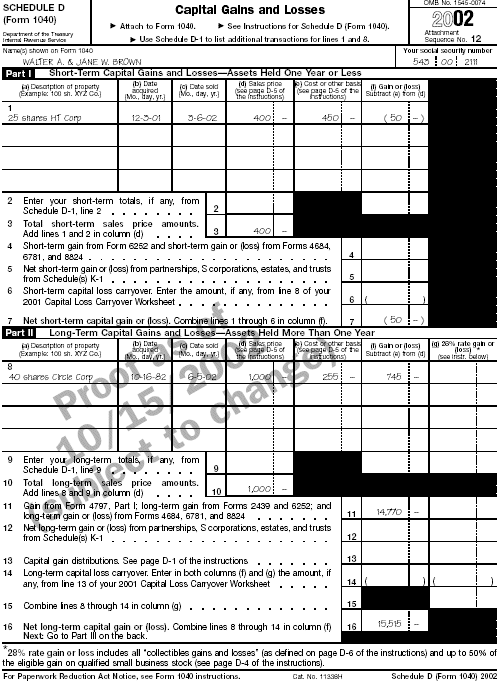
Schedule D (Form 1040) - page 1
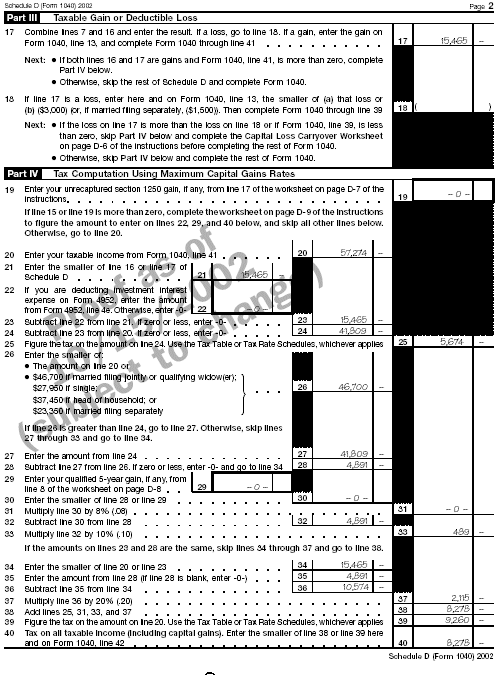
Schedule D (Form 1040) - page 2
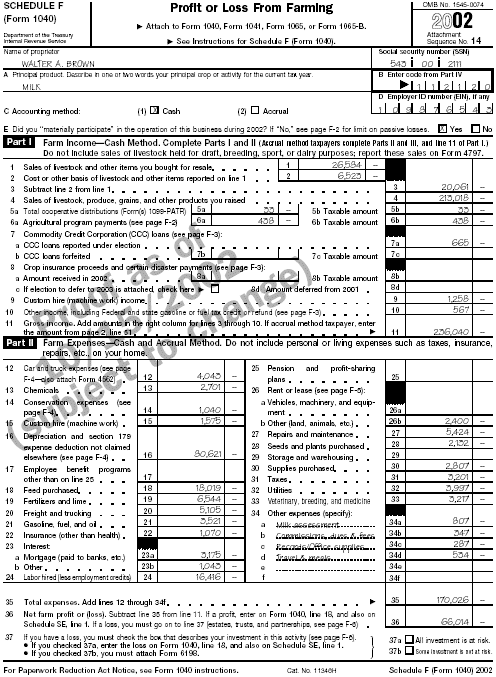
Schedule F (Form 1040) - page 1
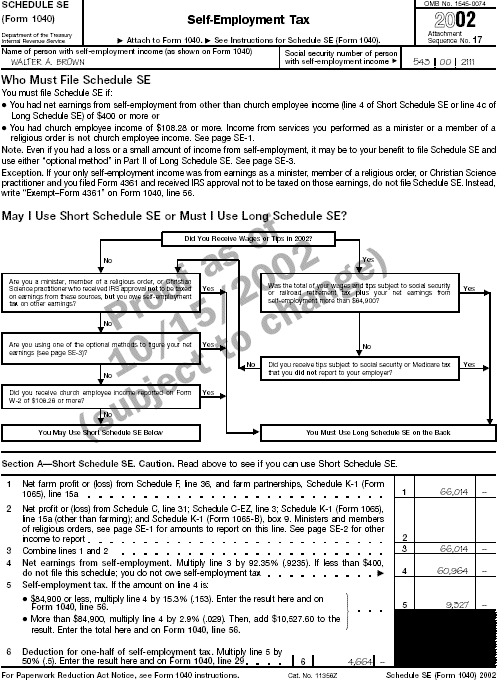
Schedule SE (Form 1040) - page 1
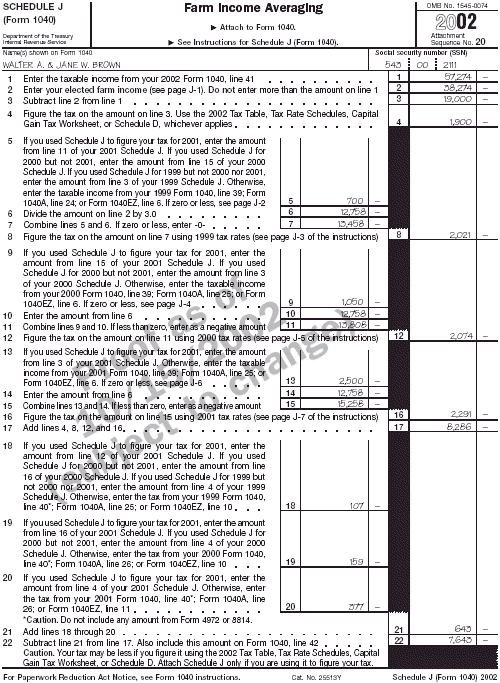
Schedule J (Form 1040) - page 1
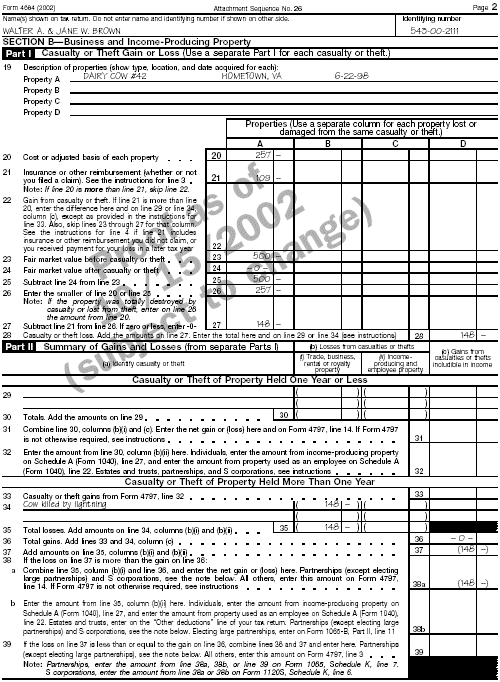
Form 4684 - page 2

Form 4797 - page 1
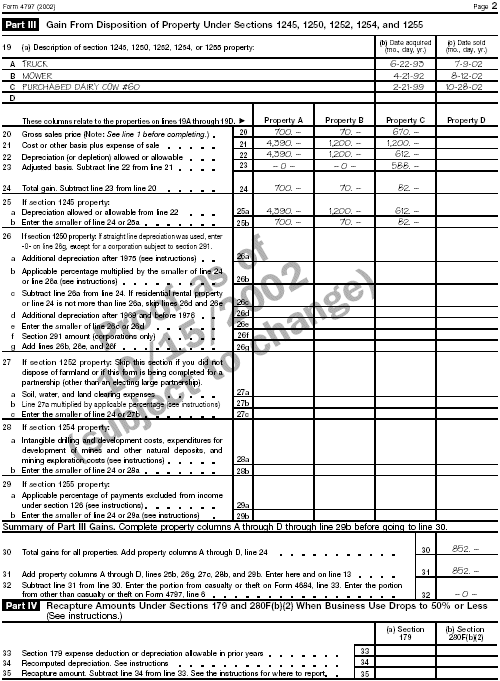
Form 4797 - page 2
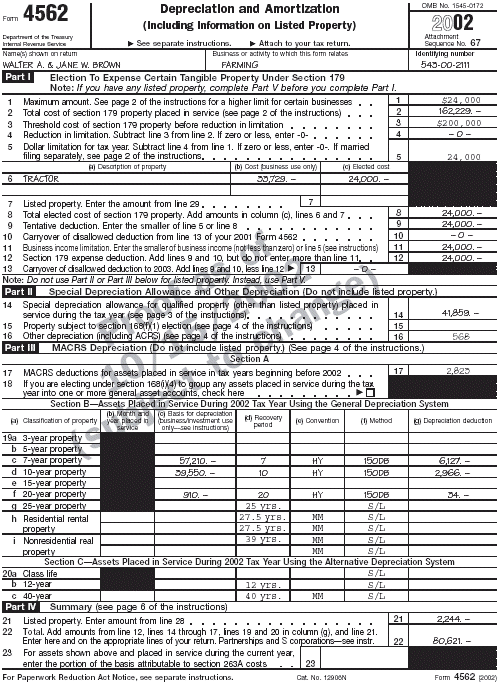
Form 4562 - page 1
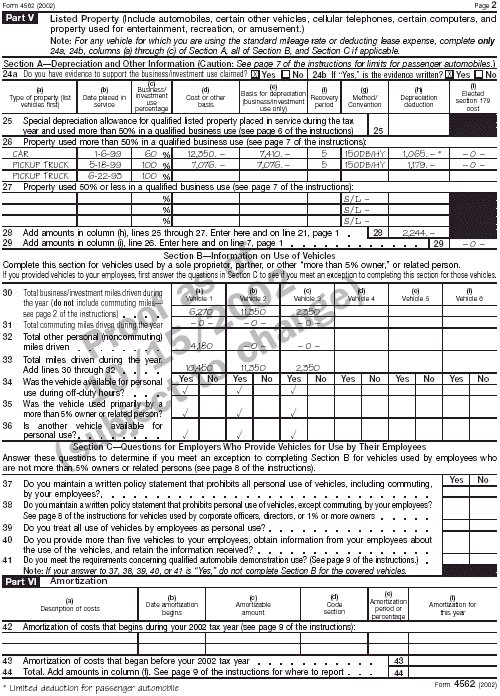
Form 4562 - page 2
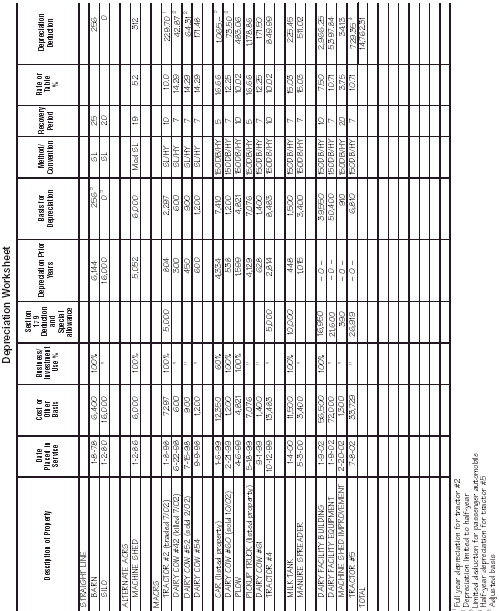
Depreciation Worksheet
How To Get Tax Help
You can get help with unresolved tax issues, order free publications and forms, ask tax questions, and get more information from the IRS in several
ways. By selecting the method that is best for you, you will have quick and easy access to tax help.
Contacting your Taxpayer Advocate.
If you have attempted to deal with an IRS problem unsuccessfully, you should contact your Taxpayer Advocate.
The Taxpayer Advocate represents your interests and concerns within the IRS by protecting your rights and resolving problems that have not been
fixed through normal channels. While Taxpayer Advocates cannot change the tax law or make a technical tax decision, they can clear up problems that
resulted from previous contacts and ensure that your case is given a complete and impartial review.
To contact your Taxpayer Advocate:
- Call the Taxpayer Advocate at
1-877-777-4778.
- Call, write, or fax the Taxpayer Advocate office in your area.
- Call 1-800-829-4059 if you are a
TTY/TDD user.
For more information, see Publication 1546, The Taxpayer Advocate Service of the IRS.
Free tax services.
To find out what services are available, get Publication 910, Guide to Free Tax Services. It contains a list of free tax publications
and an index of tax topics. It also describes other free tax information services, including tax education and assistance programs and a list of
TeleTax topics.
 Personal computer. With your personal computer and modem, you can access the IRS on the Internet at www.irs.gov. While
visiting our web site, you can:
Personal computer. With your personal computer and modem, you can access the IRS on the Internet at www.irs.gov. While
visiting our web site, you can:
- See answers to frequently asked tax questions or request help by e-mail.
- Download forms and publications or search for forms and publications by topic or keyword.
- Order IRS products on-line.
- View forms that may be filled in electronically, print the completed form, and then save the form for recordkeeping.
- View Internal Revenue Bulletins published in the last few years.
- Search regulations and the Internal Revenue Code.
- Receive our electronic newsletters on hot tax issues and news.
- Learn about the benefits of filing electronically (IRS e-file).
- Get information on starting and operating a small business.
You can also reach us with your computer using File Transfer Protocol at ftp.irs.gov.
 TaxFax Service. Using the phone attached to your fax machine, you can receive forms and instructions by calling
703-368-9694. Follow the directions from the prompts. When you order forms, enter the catalog number for the form you need. The
items you request will be faxed to you.
TaxFax Service. Using the phone attached to your fax machine, you can receive forms and instructions by calling
703-368-9694. Follow the directions from the prompts. When you order forms, enter the catalog number for the form you need. The
items you request will be faxed to you.
For help with transmission problems, call the FedWorld Help Desk at 703-487-4608.
 Phone. Many services are available by phone.
Phone. Many services are available by phone.
- Ordering forms, instructions, and publications. Call 1-800-829-3676 to order current and prior year
forms, instructions, and publications.
- Asking tax questions. Call the IRS with your tax questions at 1-800-829-1040.
- Solving problems. Take advantage of Everyday Tax Solutions service by calling your local IRS office to set up an in-person
appointment at your convenience. Check your local directory assistance or www.irs.gov for the numbers.
- TTY/TDD equipment. If you have access to TTY/TDD equipment, call 1-800-829- 4059 to ask tax
questions or to order forms and publications.
- TeleTax topics. Call 1-800-829-4477 to listen to pre-recorded messages covering various tax
topics.
Evaluating the quality of our telephone services. To ensure that IRS representatives give accurate, courteous, and professional answers,
we use several methods to evaluate the quality of our telephone services. One method is for a second IRS representative to sometimes listen in on or
record telephone calls. Another is to ask some callers to complete a short survey at the end of the call.
 Walk-in. Many products and services are available on a walk-in basis.
Walk-in. Many products and services are available on a walk-in basis.
- Products. You can walk in to many post offices, libraries, and IRS offices to pick up certain forms, instructions, and
publications. Some IRS offices, libraries, grocery stores, copy centers, city and county governments, credit unions, and office supply stores have an
extensive collection of products available to print from a CD-ROM or photocopy from reproducible proofs. Also, some IRS offices and libraries have the
Internal Revenue Code, regulations, Internal Revenue Bulletins, and Cumulative Bulletins available for research purposes.
- Services. You can walk in to your local IRS office to ask tax questions or get help with a tax problem. Now you can set up an
appointment by calling your local IRS office number and, at the prompt, leaving a message requesting Everyday Tax Solutions help. A representative
will call you back within 2 business days to schedule an in-person appointment at your convenience.
 Mail. You can send your order for forms, instructions, and publications to the Distribution Center nearest to you and receive a response
within 10 workdays after your request is received. Find the address that applies to your part of the country.
Mail. You can send your order for forms, instructions, and publications to the Distribution Center nearest to you and receive a response
within 10 workdays after your request is received. Find the address that applies to your part of the country.
- Western part of U.S.:
Western Area Distribution Center
Rancho Cordova, CA 95743-0001
- Central part of U.S.:
Central Area Distribution Center
P.O. Box 8903
Bloomington, IL 61702-8903
- Eastern part of U.S. and foreign addresses:
Eastern Area Distribution Center
P.O. Box 85074
Richmond, VA 23261-5074
 CD-ROM for tax products. You can order IRS Publication 1796, Federal Tax Products on CD-ROM, and obtain:
CD-ROM for tax products. You can order IRS Publication 1796, Federal Tax Products on CD-ROM, and obtain:
- Current tax forms, instructions, and publications.
- Prior-year tax forms and instructions.
- Popular tax forms that may be filled in electronically, printed out for submission, and saved for recordkeeping.
- Internal Revenue Bulletins.
The CD-ROM can be purchased from National Technical Information Service (NTIS) by calling 1-877-233-6767 or on the
Internet at http://www.irs.gov/cdorders. The first release is available in early January and the final release is available in late
February.
 CD-ROM for small businesses. IRS Publication 3207, Small Business Resource Guide, is a must for every small business owner or
any taxpayer about to start a business. This handy, interactive CD contains all the business tax forms, instructions and publications needed to
successfully manage a business. In addition, the CD provides an abundance of other helpful information, such as how to prepare a business plan,
finding financing for your business, and much more. The design of the CD makes finding information easy and quick and incorporates file formats and
browsers that can be run on virtually any desktop or laptop computer.
CD-ROM for small businesses. IRS Publication 3207, Small Business Resource Guide, is a must for every small business owner or
any taxpayer about to start a business. This handy, interactive CD contains all the business tax forms, instructions and publications needed to
successfully manage a business. In addition, the CD provides an abundance of other helpful information, such as how to prepare a business plan,
finding financing for your business, and much more. The design of the CD makes finding information easy and quick and incorporates file formats and
browsers that can be run on virtually any desktop or laptop computer.
It is available in March. You can get a free copy by calling 1-800-829-3676 or by visiting the website at
www.irs.gov/smallbiz.
Previous | First
Publication Index | 2002 Tax Help Archives | Tax Help Archives | Home
